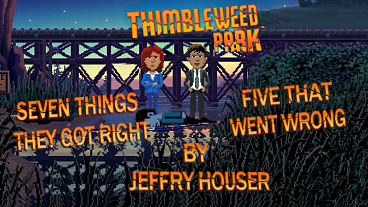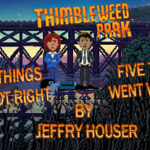
ThimbleWeed Park: Seven Things They Got Right and Five That Went Wrong
No game is perfect, but I enjoyed the time I spent on Thimbleweed Park. Give it a shot, and you won’t be disappointed.
Thimbleweed Park is the latest game from Ron Gilbert and Gary Winnick, two creators of classic adventure games including Monkey Island and Maniac Mansion. My colleague Greg Collins is doing a full review, but I want to take some time to highlight a few items that the game got right, and a few that didn’t turn out as I’d hoped. This article is primarily spoiler-free, but you may want to play the game before diving in.
Here is a list of seven things that I think the game does really well:
1) Music: The highlight of Thimbleweed Park is the music. Whoever did the soundtrack deserves an award for it. (Editor’s note: that would be Steve Kirk). Usually, when I pause a game to go fold laundry or refill a cup of water, I mute the computer. With Thimbleweed Park, I found myself turning it up. The soundtrack is a joy to listen to and perfected the mood of the game.
2) Length: Thimbleweed Park is one of the longest adventure games I’ve played in ages. It took me more than 15 hours to complete and I was never left bored, stuck, or confused. Even with 15 hours, I only have 70% of the Steam Achievements and haven’t even tried the casual mode yet. This game provides a lot of bang for the buck.
3) Graphics: Under normal circumstances, I am sick of the retro-pixel art approach to adventure games. These games often look horrible on my big monitor and this detracts from the gameplay rather than adding to the nostalgia. Thimbleweed Park avoids this trap. It uses a similar graphical pixel approach, but the game does not feel like a retro game. The resolution fills my screen without stretching. The streets of the town are long and sprawling instead of short and stunted. The animations make the characters come alive. The game is a beauty to look at.
4) It has an ending: This game has an ending. You don’t have to worry about walking out into an amusement park only to be left confused and then later discover that the game creator left the company and won’t be finishing his story.
5) Puzzles: The puzzles in this game are cleverly designed. There is no moon logic that we love to find in adventure games. You won’t need to collect specks of dust so you can create a cotton swab so you can get some ear wax which you use to make a candle to light your way through the dark cave. There is none of that. The puzzles fit well into the narrative.
6) Verb Interface: Instead of using today’s standard single mouse cursor interface, the game takes up some screen real estate to add some action verbs akin to the old LucasArts games. I was worried that this would add extra clutter to the UI and that it would be a pain to use. Games such as The Book of Unwritten Tales have spoiled me in their simplicity.
For the most part, this doesn’t matter. When your mouse rolls over an item with which you can interact, one button-click looks at it and the other button picks a secondary default interaction with the item. In 90% of the cases, this wil get you through the game. But don’t let your guard down,as in the other 10% you’ll have to choose one of the verbs to interact with an item in a third way.
7) What Do I Do Next? Some adventure games leave you confused as to what where you’re supposed to go next, and what you’re supposed to do. Thimbleweed Park has managed to avoid that trap. Each character keeps his/her own list of tasks, and the game automatically updates the task so you know what’s done and what remains. If you are stuck with one character, you can easily jump to another and work on that character’s tasks until you figure out the sticking point.
Unfortunately, no game is perfect, and here are some of the things that could have used some improvement.
1) Character Arcs: You play as five separate characters throughout the game. I love the way they roll out the new character introductions and start them in with the gameplay. Unfortunately, a lot of the questions about the character motivations and backstory are never resolved. Instead, they are replaced with a completely different plot thread near the end of the game. I was a bit bummed about this method of handling the mysteries that draw you in.
2. Character Collaboration: The five characters have no reason to start working together. You force it to happen because you control them and can start sharing items between characters, something important for many puzzles. But this collaboration has no logical start in the game. Additionally, since we need to share items between characters, it is difficult to do so. Both characters need to be standing next to each other to make it work. Day of the Tentacle had a great mechanism for exchanging items between players. you could drop the item onto the user’s icon. Unfortunately, Thimbleweed Park neglects this feature. While realistic, it does not alleviate the frustration of having to run across town to get an item you think you may need from another character.
3) Humor: The humor in the game comes from ridiculing the Adventure genre or referencing past LucasArts games. While I enjoyed it in the beginning, it started to wear on me. They push the one-trick pony way too far. I can laugh at the occasional, “If this were a Sierra Game, I’d be dead already” comment and chuckle at Ron Gilbert’s book about how to create a trilogy in two parts. Overall, I feel there is too much reliance on breaking the fourth wall and regurgitating the same old joke in a new form. This will be great for old-school gamers who adventured in the 80s and 90s, but any newbies will miss most of the humor.
4) Multiple Endings: The original Kickstarter campaign promised meaningful multiple endings. This is technically true, but all endings I found have minor variations on the same theme. It’s like saying my day is different because I put on my shoes after walking downstairs instead of before. Sure, that is a variation to my morning routine, but it is inconsequential.
There’s no inducement to replay the game in order to reach a different ending the way there might be for a Telltale game, or even something such as King’s Quest 6.
5) Dialog Skip: I gave credit to the Verb Interface in the previous section as one of the things they did right, but the user interface is far from perfect. Taking a cue from the new King’s Quest game, they did not include a way to skip dialog. Words cannot express how annoying this is. I just read the text on the screen, why do I have to wait for the person to finish talking before I can continue playing the game? Especially when I’m stuck and have already heard this line a dozen times before. I am shocked that the game got this far without providing this basic feature. Do game developers actually play adventure games anymore?
No game is perfect, but I enjoyed the time I spent on Thimbleweed Park. Give it a shot, and you won’t be disappointed.

Leave a Reply